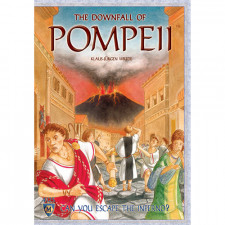The Downfall of Pompeii Review
on May 5, 2015
I have to say, it's not very often that a game can impress me enough to make me view it as a really great game, or even close. However, it always seems to be a surprise to me when it does, and this is true of Mayfair Games’ Downfall of Pompeii. Once I got my head around it, this game had me sitting there like that dude from the old Memorex commercials with his hair blown back, almost literally. I bought it here at Miniature Market about a month ago, and I haven't stopped playing it since. For as simple as it is, and despite it lacking a crucial component that all games should include (dice) it still rocks like igneous and also manages to have enough luck to make it random, but not overly so.
Make no mistake- despite the antiquity setting the game is not about collecting urns and uplifting civilization, but about people being melted by lava wholesale. It really can be summed up with one sentence, "try to give your opponents' dudes a fiery, Vesuvian grave faster than they can sear the skin off of yours." The game comes with a really cool little plastic volcano to boot, despite the other components being wooden, octagonal cylinders that somehow represent people. The only things missing from the experience is a tea light to set inside the volcano, which I bought almost immediately, and one of those Halloween sound effect boxes that plays clips of blood-curdling screams.
The game is absurdly fun and viewed critically it's far more fun than it really deserves to be. That said, I'll take "fun" over "brain-burning chore" 100 of 100 times, and twice on a Sunday. There's no deal-making, no pleading for mercy; this is about two to four players spending forty minutes attempting to be accessories to mass murder by volcano. And it's glorious. Yes, it does have at least some modicum of deep strategy going on, but it kind of takes a back seat to the visceral joy found in setting your opponents' people ablaze.
What makes it fun, more than anything, is that it's so utterly brutal. There's three acts, so to speak, with the first and second having players place their little doomed souls on the board, ideally as close to the exits as possible. This is accomplished by playing one of the four cards in your hand, color-matched and numbered to coincide with the buildings on the board. Play a card, drop a dude on the map, and that's your turn. In the second act, it's the same as that, but you can place more people to ensure more carnage, or if you prefer, strategic options. It's the last act that takes the game from merely interesting and amusing to almost indescribably bad ass. See, once the volcano erupts, which is managed by a randomly-timed card draw, all the placement cards get put back in the box and the real fun begins.
This third act has players placing lava tiles, each with an icon upon them which determines which area of the board they may emerge on. Six are placed immediately and thereafter each player takes a turn placing a tile and then moving two of your own little dudes around the board. There's an interesting movement mechanic which allows players to move as many spaces as there are dudes on their origin space, which is slick because it guarantees that all the dudes on the board will be mostly bunched up in anticipation of their great escape. The lava flows can be placed on a space that is occupied, meaning those people are instantly incinerated, to be found two thousand years later, or can be used to block paths. If a little dude is in an area from which there is no escape route, they are immediately killed as well. One note of great import here is that you don't just grab them and toss them in the box, you literally toss them, El Grande style, into the fiery mountain. This is where that Wilhelm scream box would come in handy. I don't know why it's so satisfying, but it absolutely is, which is evidenced by the fact that my wife and kids look over at me and give that evil smirk that only wives and kids do when they've screwed Dad over.
Now, if there's any downside to the game, it's found in setting up the card deck. It's sort of like Pandemic where you have to stack cards in a certain order, then shuffle those little decks, then stack the decks in a predetermined order. It sucks, it's tedious, and initially, it was substantially confusing, which led to our first game lasting around 15 minutes due to the timing being screwed up. The next time I played, I made almost the same mistake again, screwing that game up too. I mean, I read the rules and followed the instructions, so what could go wrong? Well, what I didn't do was look at the illustration. They say a picture is worth a thousand words, and apparently, they're right. Once I meditated upon the photo for a minute, it became instantly clear. From that point forwards it was a piece of cake.
The "TL/DR" version is that I adore this game wholeheartedly, and I cannot recommend it enough. It does for us what Survive! Escape from Atlantis did, but with a bit of a historical flair and some solid artwork to boot. Its only flaw is that setup is a pain, and maybe- and this is a big maybe- some people might not like it because it does have a bit of luck going on due to the card draws and lava tile icons affecting play. Well, the people in Pompeii ran out of luck, so what makes you think you shouldn't have to?

 Customer Support
Customer Support  Subscribe
Subscribe 




 Account
Account  Wishlist
Wishlist 

